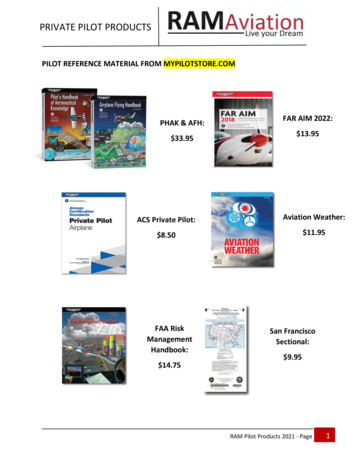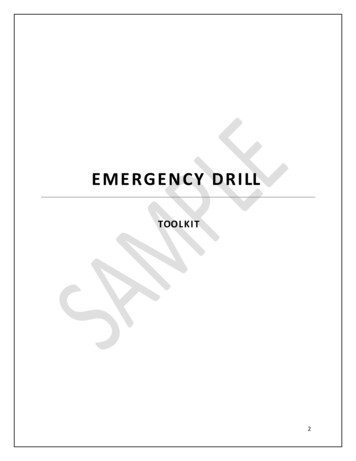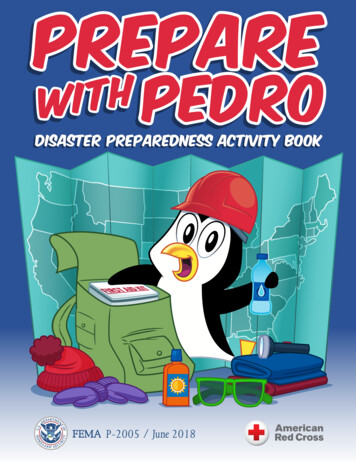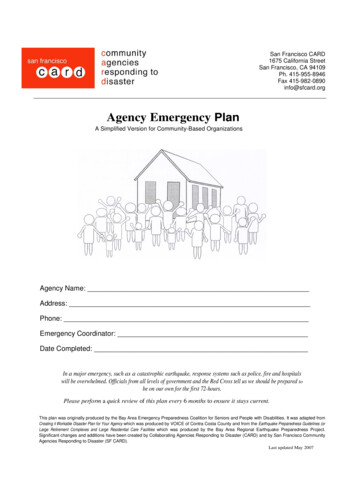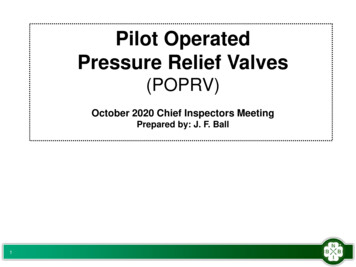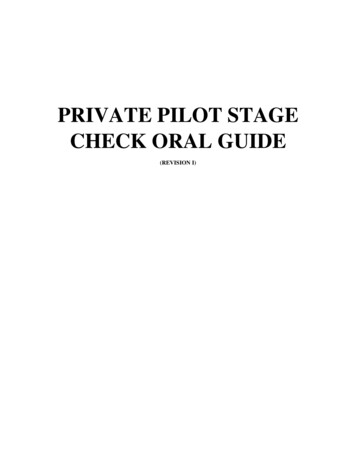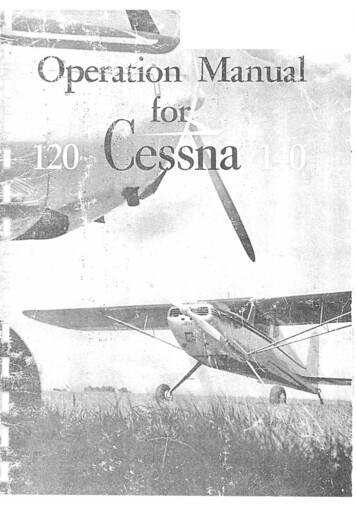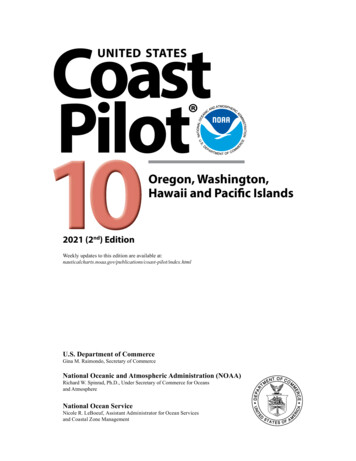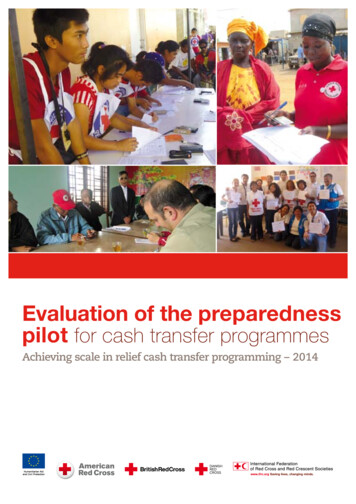
Transcription
Evaluation of the preparednesspilot for cash transfer programmesAchieving scale in relief cash transfer programming – 2014
International Federation of Red Crossand Red Crescent Societies, Geneva, 2014Copies of all or part of this study may be made for noncommercial use,providing the source is acknowledged The IFRC would appreciate receiving details of its use. Requests for commercial reproduction shouldbe directed to the IFRC at secretariat@ifrc.org.This document has been produced with the financial assistance of theEuropean Commission. The views expressed herein should not be taken,in any way, to reflect the official opinion of the European Commission.Report prepared by Hisham Khogali and Christine South.The opinions and recommendations expressed in this study do not necessarily represent the official policy of the IFRC or of individual NationalRed Cross or Red Crescent Societies. The designations and maps useddo not imply the expression of any opinion on the part of the International Federation or National Societies concerning the legal status of aterritory or of its authorities. All photos used in this study are copyright ofthe IFRC unless otherwise indicated. Cover photo: Philippine Red Cross,Senegalese Red Cross Society, Viet Nam Red Cross Society, ChileanRed Cross.P.O. Box 303CH-1211 Geneva 19SwitzerlandTelephone: 41 22 730 4222Telefax: 41 22 733 0395E-mail: secretariat@ifrc.orgWeb site: www.ifrc.orgEvaluation of the preparedness pilotfor cash transfer programme1260000 05/2014 EFollow us on:
International Federation of Red Cross and Red Crescent SocietiesEvaluation of the preparedness pilot for cash transfer programmeEvaluation ofthe preparedness pilotfor cash transfer programmesAchieving scale in relief cash transfer programming – 2014The International Federation of Red Cross and RedCrescent Societies (IFRC) is the world’s largest volunteerbased humanitarian network. Together with our 189member National Red Cross and Red Crescent Societiesworldwide, we reach 97 million people annually throughlong-term services and development programmes aswell as 85 million people through disaster response andearly recovery programmes. We act before, during andafter disasters and health emergencies to meet theneeds and improve the lives of vulnerable people. Wedo so with impartiality as to nationality, race, gender,religious beliefs, class and political opinions.Guided by Strategy 2020 – our collective plan of actionto tackle the major humanitarian and developmentchallenges of this decade – we are committed to ‘savinglives and changing minds’.Our strength lies in our volunteer network, our communitybased expertise and our independence and neutrality.We work to improve humanitarian standards, as partnersin development and in response to disasters. We persuadedecision-makers to act at all times in the interests ofvulnerable people. The result: we enable healthy andsafe communities, reduce vulnerabilities, strengthenresilience and foster a culture of peace around the world.1
International Federation of Red Cross and Red Crescent SocietiesEvaluation of the preparedness pilot for cash transfer programmeContentsExecutive summary4Part 1. Introduction5Part 2. Methodology7Part 3. Programme context83.1 National Society selection criteria83.2 National Society experience in cash transfer programming93.2.13.2.23.2.33.2.4Viet Nam Red Cross SocietyPhilippine Red CrossSenegalese Red Cross SocietyChilean Red Cross3.3 Theory of change – the logic of interventionPart 4. Findings4.1 Description of achievements against country level plans4.1.14.1.24.1.34.1.4Viet Nam Red Cross SocietyChilean Red CrossPhilippine Red CrossSenegalese Red Cross Society4.2 Cash transfer programme standard operating procedures, finance and reporting4.2.1 Standard operating procedures4.2.2 Financial systems4.2.3 Reporting, monitoring and evaluation4.3 Human resource capacity development4.3.1 Staff and volunteers4.3.2 National Society leadership4.4 Contingency planning and preparedness for cash transfer programming4.4.1 Contingency planning4.4.2 Cash transfer mechanisms4.5 Operational tools and actions4.5.1 Operational tools4.5.2 Trained national disaster response teams4.6 Communication and coordination4.6.1 Internal communication4.6.2 External communication and coordination4.7 Global technical 262728282930
International Federation of Red Cross and Red Crescent SocietiesEvaluation of the preparedness pilot for cash transfer programmePart 5. Conclusion325.1 Impact335.2 Efficiency375.3 Connectedness38Part 6. Recommendations39Annexes43Annex 1. Terms of reference43Annex 2. Documents referred to for desk review52Annex 3. Evaluation questions53Annex 4. Global key informant list55Annex 5. Country visit key informants553
International Federation of Red Cross and Red Crescent SocietiesExecutive summaryExecutive summaryIt is recognized that cash transfer programming can be effective in supportingpopulations affected by disasters in a way that maintains dignity and choicefor beneficiaries while stimulating local livelihoods, economies and markets.However, the majority of cash transfer programming has been undertaken afterthe immediate operation response to meet recovery outcomes.Between May 2012 and December 2013, the International Federation of RedCross and Red Crescent Societies (IFRC) provided support to four pilot NationalSocieties namely the Philippine Red Cross, the Viet Nam Red Cross Society, theSenegalese Red Cross Society and the Chilean Red Cross through training andcoaching to ensure cash transfers and market assessment are embedded intotheir existing preparedness measures and contingency planning. This was doneto ensure that during an operation with scalable cash transfer component,the programme could be rapidly implemented to meet the immediate or reliefneeds of the affected population.The findings of the evaluation suggest that the Viet Nam Red Cross Society andthe Philippine Red Cross have demonstrated a capacity to scale up cash transferprogramming in relief. While the Senegalese Red Cross Society and the ChileanRed Cross have the basis to be able to scale up cash transfer programming reliefresponse to future disasters.It is notable that all four National Societies’ leadership accepted and supportedcash transfer programming as a form of intervention in relief. This reflectsa marked change of thinking and practice compared to before the pilot wasimplemented. The change is reflected through the following achievements: All National Societies have a cash focal point and a critical mass of trainedstaff and volunteers ensuring that skills, knowledge and experience are retained for future operations. National Societies have templates and tools including those for market assessments, some of which have already been tested, adapted to local context andtranslated, for use in planning and implementation of cash transfer programming responses in the future. Two of the National Societies succeeded in developing standard operating procedures (SOPs) for cash transfer programming. All National Societies have the basis to sustain cash transfer programming inthe future as they have institutionalized the procedures, tools and templates. All National Societies have engaged in external fora and working groups notonly sharing their experience, but also to learn from others and to coordinatefuture responses. This evaluation makes specific recommendations for each National Society,as well as institutionalizing cash-based programming and capacity buildingmodel for future preparedness efforts.4
International Federation of Red Cross and Red Crescent SocietiesPart 1 Introduction1.IntroductionNational Red Cross and Red Crescent Societies have more than a decade’s experience of using cash transfer programming in disaster response. The IndianOcean tsunami response in 2004 was a turning point for the Red Cross and RedCrescent in the use of cash transfers in disaster relief and recovery programming. From the learning and experience gained from this mega disaster, therewas an increased acceptance in using cash transfers in responding to majoremergencies such as the Pakistan earthquake (2006), Cyclone Sidr in Bangladesh(2007), Haiti earthquake (2010), Pakistan floods (2010), Sahel crisis (2011) andPhilippines typhoons (2012).It is recognized that cash transfer programming can be effective in supportingpopulations affected by disasters in a way that maintains dignity and choice forbeneficiaries while stimulating local livelihoods, economies and markets.However, the majority of cash transfer programming thus far has been undertaken to address recovery needs.Three strategic objectives have been identified to guide the IFRC’s work to meetits Global Cash Transfer Programming Strategy 2012–2013:1.2.3.Support more rapid and scalable responses through institutionalizing andmainstreaming cash transfer programming within IFRC operational responses.Capacity building through targeted training, coaching and technical support.Knowledge management and strengthened advocacy and dissemination ofappropriate use of cash transfer programming.At the global level, significant investment is being made by the IFRC secretariatto clarify the procedures and develop the systems and mechanisms to be ableto deliver cash transfers. Efforts are also being made to institutionalize andmainstream cash in IFRC’s disaster response tools. Focus at the country level ison capacity building, generating good practice and operational evidence as wellas developing preparedness for cash transfer programming approaches.In order to develop a preparedness approach to cash transfer programming,four National Societies, namely the Philippine Red Cross, Viet Nam Red CrossSociety, Senegalese Red Cross Society and Chilean Red Cross, were selected forthe implementation of the preparedness pilot project. The National Societieswere identified in consultation with the zone disaster management coordinators and the senior officer for preparedness (as well as Danish Red Cross1 for twolocations).1 The Danish Red Cross partfunded the cash transferprogramming preparednesspilot project.5
International Federation of Red Cross and Red Crescent SocietiesEvaluation of the preparedness pilot for cash transfer programmeIcons used in the tablesfor outcome categories:SOPs, plans,reporting, systemsHuman resource capacityThe IFRC secretariat worked with the four pilot countries between May 2012and December 2013 to support the National Societies with training andcoaching, ensuring cash transfers and market assessment are embedded intotheir existing preparedness measures and contingency planning. This was donewith the aim that future operations with a scalable cash transfer componentcan be rapidly implemented.This evaluation reviews the work done by the four National Societies and theIFRC secretariat to develop a preparedness approach. The objective of the evaluation is to, “Review the progress made by all four pilot countries and assess theextent to which they are now able to respond using cash, and to do so at increased scale compared to previous operations.”The terms of reference (refer to Annex 1), further define specific questions toguide the evaluation process.The principles and guidance provided in the IFRC Framework for Evaluation hasbeen used to guide the process to ensure that the evaluation:Contingency planning,transfer mechanismsidentified and preparedOperational toolsand actionCommunication andcoordination6 Improves the work of the IFRC to help those in need.Contributes to organizational learning.Upholds accountability and transparency.Promotes and celebrates the work and achievements made.
International Federation of Red Cross and Red Crescent SocietiesPart 2 Methodology2.MethodologyThis evaluation was carried out between January and February 2014 by an independent consultant and a staff member of the IFRC secretariat. Neither theconsultant nor the staff member were involved in the cash transfer programming preparedness pilot project.The evaluation team undertook a review of secondary data provided by the IFRCsecretariat and the four National Societies involved in the pilot. A list of keydocuments reviewed is provided in Annex 2.In addition, key informants were interviewed including global focal points inGeneva and the zone secretariat offices, Participating National Societies anddonor representatives from European Commission Humanitarian Office (ECHO).Annex 3 contains the evaluation matrix with the questions used for the interviews. A full list of global key informants can be found in Annex 4.Country visits were undertaken to three of the four National Societies. TheNational Societies visited were the Senegalese Red Cross Society, Viet Nam RedCross Society and the Philippine Red Cross. The visits enabled the evaluationteam to engage with the National Society staff and volunteers involved in thepreparedness activities at headquarters and branch level. Annex 5 includes alist of key informants from each country visit.ConstraintsDue to time constraints, it was not possible to visit the Chilean Red Cross.Furthermore, the evaluation team did not include a Spanish speaker. Therefore,the evaluation team conducted interviews with key informant staff of theChilean Red Cross and IFRC secretariat zone over the telephone with the support of an interpreter.As a result of time constraints and the focus of the evaluation on secondarydata, the evaluation team had to limit the number of global key informants whowere interviewed. The time given for feedback on the draft evaluation reportwas also limited for the same reason.7
International Federation of Red Cross and Red Crescent SocietiesEvaluation of the preparedness pilot for cash transfer programme3.Programme contextThe preparedness pilot project was implemented in partnership and with support from the ECHO, the Cash learning Partnership (CaLP), Danish Red Crossand British Red Cross. The project was managed overall by the IFRC senior officer for recovery in conjunction with the relevant zone offices. This sectionprovides an overview of how the National Societies were selected for the pilotproject and their cash transfer programming experience to date. It also elaborates on the theory of change that the cash transfer programming preparednesspilot followed.3.1 National Societyselection criteriaThe selection criteria of National Societies to participate in the pilot was documented in the project’s concept note. In agreement with the disaster management coordinators, it was established that the pilot National Societies would beidentified from zones with the most experience in cash transfer programming.A review of all emergency appeals issued from 2007 to 2011 was undertaken todetermine this. 2 Based on the review, it was decided that two of the pilotNational Societies should be from the Asia Pacific, one from Africa and one fromthe Americas.In addition to the geographical criteria, it was agreed that the country should:2 A cash transfer programmingcomponent was included in: 66 per cent of all appealsin Asia Pacific zone; 36 per cent of all appealsin the Americas zone; 27 per cent of all appealsin Africa zone; and Less than five per cent ofall appeals in the Middle Eastand North Africa and Europezones.8 Be prone to hazard. Have good experience of cash transfer programming within the National Society. The National Society should also be willing to participate in and committo the pilot and deliver cash at scale following the next major disaster. Have a market and economy conducive to cash transfer programming. Have a positive enabling environment (such as a government open to cashtransfer programming, etc.). Have a regional CaLP focal point. Be a DANIDA/Danish Red Cross priority country (two out of the four pilotswere funded by the Danish Red Cross).The two pilot National Societies in Asia Pacific started with the implementationof the project in 2012. The National Societies in Africa and the Americaslaunched the project in June 2013. Therefore, there was a difference in theimplementation periods for the pilots for each National Society.
International Federation of Red Cross and Red Crescent SocietiesPart 3 Programme context3.2 National Society experiencein cash transfer programming3.2.1 Viet Nam Red Cross SocietyViet Nam is prone to different types of hazards including typhoons, floods andto lesser extent earthquakes. The Viet Nam Red Cross Society first used an unconditional cash transfer modality in response to the 2009 Typhoon Ketsana.This programme was supported by the American Red Cross and provided anunconditional cash transfer for relief needs to 8,582 households. In 2011, theViet Nam Red Cross Society used different forms of cash transfer including conditional and unconditional cash transfers in response to the Mekong floods.This response used vouchers and cash to support an owner-driven housing project. The unconditional cash transfer targeted 1,500 households out of a totalresponse target of 10,000 households.The Viet Nam Red Cross Society, therefore, had considerable experience of cashtransfer programming prior to the preparedness pilot. In addition to havingstaff that have experience in cash transfers, the National Society had alreadyinvested in the development of the SOPs and Guidelines on Cash DistributionProcedures, which has been adjusted based on lessons learnt from operations.It should be noted that the Government of Viet Nam also uses cash transfers inits response to disasters, often providing cash for bereavement and damagedproperty. This is important as it provides an enabling environment for cashtransfer programming.3.2.2 Philippine Red CrossThe Philippines is prone to many types of hazards, the predominant ones beingtyphoons and floods. The Philippine Red Cross has extensive experience in theuse of cash transfer programming since 2009. The majority of this experiencehas been in the use of vouchers and conditional cash transfers to meet livelihoods and shelter needs. In 2012, the National Society implemented its firstunconditional relief cash transfer programming following the floods in MetroManila to meet the diverse relief needs of the affected population.The Philippine Red Cross had already established links and secured the servicesof cash remittance service providers. LBC Express and GCash providers werecontracted at the same time. The selection was done in 2011 from a group ofidentified financial service providers following an initial study carried out byCaLP and experience of other NGOs in the country post-Typhoon Ketsana. BothLBC Express and GCash have been used as service providers for all cash transferprogramming operations since 2011.The Government of the Philippines also uses cash disbursements in the 4P 3programme which provides conditional cash transfers. The 4P programme ispart of the Government of Philippines Social Protection mechanism and aims toeradicate poverty.3 For more information onthe 4P programme, referto pantawid.dswd.gov.ph/9
International Federation of Red Cross and Red Crescent SocietiesEvaluation of the preparedness pilot for cash transfer programme3.2.3 Senegalese Red Cross SocietyBesides health emergencies, Senegal faces two main hazards, namely food insecurity and floods. The Senegalese Red Cross Society had experience in cashtransfer programming prior to the preparedness pilot. However, the NationalSociety clarified that cash transfer programming implementation was normallycarried out approximately three-months after the disaster.The National Society implemented the cash for shelter programme in 2010 to2011 funded by the Kuwaiti Fund following the floods. The cash transfer wasconditional but provided direct-cash to 15,000 beneficiaries. Conditional cashwas also provided for income-generating activities for 4,000 female-headedhouseholds.The National Society had experience of cash for work with a disaster relief andemergency fund (DREF) funded flood response in 2011. This cash response targeted 1,000 urban households.In 2012, cash vouchers were provided under the emergency appeal in responseto the food insecurity which targeted 1,071 households in Saint Louis. In addition, the National Society reported that it had implemented a cash voucherprogramme in collaboration with the World Food Programme (WFP) as part ofthe response to the food crisis to 136,000 beneficiaries.The National Society has had some previous experience implementing cashtransfer programming in the form of direct-cash and vouchers. However, it doesnot have experience in designing a cash transfer programme.3.2.4 Chilean Red CrossChile is prone to earthquakes and volcanic eruptions as well as other hazardssuch as fires. The Chilean Red Cross has provided e-vouchers, which could beused to buy up to 200 US dollars’ worth of tools and construction materialsfrom a network of designated hardware stores. The ‘Tarjeta ReD’ (Reconstructionand development card) cash transfer programme helped 8,400 families rebuildor repair their homes following the 2010 earthquake.3.3 Theory of change –the logic of interventionIn order to determine the impact of the cash transfer programming preparedness pilot, the evaluation team constructed a logic model using the countryplans submitted by the National Societies. While each National Society has different capacities in cash transfer programming, the overall logic of the planswas similar (refer to Diagram 1).10
International Federation of Red Cross and Red Crescent SocietiesPart 3 Programme contextActivitiesOutcomesImpactDiagram 1. Theory of change for cashpreparedness pilot projectRapid and large-scale CTP* responseSOPs, StrategicPlans, Reporting,SystemsHuman ResourceCapacityDevelopment(skills, knowledge,mindset, attitude)ContingencyPlanning andpreparednessfor CTPOperationalTools and ActionCommunicationand Coordination(internal andexternal)- Develop SOPs(or use IFRC SOPs)- Adapt financialsystem- Adapt monitoringand evaluationsystems- Train leadershipof NationalSociety- Train staffand volunteers- Simulationexercise- Developingor adaptingcontingencyplans for CTP- Research andprepare mostappropriatecash transfermechanism- Assessment(e.g. market)tools adjustedfor CTP- NDRT** trainedand preparedfor CTP- Agreements,templates etc.set-up- Developadvocacymessages(internal andexternal)- Coordinateactions with otherorganizations- Share learningwith/from otherorganizations* Cash transfer programming has been abbreviated to CTP** National disaster response team has been abbreviated to NDRTThe cash transfer programming preparedness pilot was undertaken recognizingthat investment in National Society preparedness is required to meet the needsof disaster affected people in a timely way. CaLP’s study Ready or Not? EmergencyCash Transfers at Scale highlights four key areas of preparedness: Appropriate procedures, systems and guidelines to facilitate rapid large-scalecash and voucher transfer programming. Technical capacity to assess needs, design appropriate programmes, implementand monitor these. Contingency planning including relevant analysis and prepositioning activities. Coordination with other actors, particularly the private sector.This suggests that the logic followed by the pilot programme is in line with current thinking on both the need for preparedness to deliver cash response atscale and at speed to meet needs. This approach is also in line with AmericanRed Cross’s Cash Transfer Programming Preparedness framework4 currently underdevelopment. Both approaches build on initial awareness raising through tocapacity development of staff, contextualizing tools and operationalizing skillsand knowledge.4 American Red Cross draftCash Transfer ProgrammingPreparedness Framework11
International Federation of Red Cross and Red Crescent SocietiesEvaluation of the preparedness pilot for cash transfer programme4.FindingsThis section examines the expected outcomes as described in the theory ofchange to determine the progress made by each National Society and to determine the lessons learnt for future preparedness programmes.4.1 Description of achievementsagainst country level plansThe following section details the activities of each National Society and theirachievements to date.4.1.1 Viet Nam Red Cross SocietyThe Viet Nam Red Cross Society updated and translated its SOPs to reflect recent market assessment work. This enabled the National Society to determinestandardized cash transfer values based on the number of household members.These SOPs were valuable in the training of provincial, district and communelevel staff and volunteers and proved useful in responding to Typhoon Wutip in2013. The SOPs also contain the templates that should be used in cash transferprogramming response.DURING THE 2013 TYPHOONWUTIP OPERATION,4,784households receivedunconditional cash transferin the relief phaseThis equates to70%of the total targetedhouseholds receivingcash grants12The Viet Nam Red Cross Society has also developed beneficiary communicationtools including brochures and posters. These explain the cash transfer programming process including targeting criteria and entitlements.The National Society is also a participant in an in-country consortium on cashtransfer programming with NGOs. It has also raised the profile of cash transferprogramming in-country by preparing a presentation for the disaster management working group in Viet Nam.Table 1 highlights the Viet Nam Red Cross Society’s planned outcomes, activitiesand achievements. The Viet Nam Red Cross Society reaffirmed its commitmentto cash transfer programming by using its own disaster response fund to undertake cash transfer programming to approximately 10,000 beneficiaries. Thishighlights the commitment at senior level within the National Society to theuse of cash transfer programming.
International Federation of Red Cross and Red Crescent SocietiesPart 4 FindingsTable 1. Planned outcomes, activities andachievements of the Viet Nam Red Cross Societypilot cash preparedness ranslation of SOPs into Vietnamese Awareness raising and advocacy module workshop withleadership and governance to discuss barriers and constraints tocash transfer programming as well as opportunities Carry out cash transfer programming training(August 2012) Focal persons of the National Society (headquarters) and IFRCdelegation attended a training of trainers in the United Kingdom inOctober 2013 Viet Nam Red Cross Society headquarters focal person attendedNational Society cash transfer programming learning workshop inGeneva in May 2013 Revised translation of the training materials Integrate cash transfer programming componentinto the National Society’s contingency planOngoingExplored potential private sector providers for cash disbursement Market assessments undertaken Knowledge sharing with INGOs (the National Society’s provincialchapter shared cash transfer programming experiences at thelearning event) Cash transfer programming preparedness workshop includingproject inception 4.1.2 Chilean Red CrossThe Chilean Red Cross has trained a critical mass of staff and volunteers oncash transfer programming. In addition, the National Society has undertakenmarket assessments and explored agreements with traders and banks as alternative cash transfer modalities.As is highlighted in the plan, the two main areas that were not achieved by theChilean Red Cross were the development of SOPs for cash transfer programming and the integration of the same into contingency plans. However, the focalpoint reports that there is on-going work to integrate cash transfer programming into response plans at branch level.Within the preparednesspilot time frame, the ChileanRed Cross contributed to6trainings which benefitedother National Societieswithin the region.This equates to100additional people trained incash transfer programming.13
International Federation of Red Cross and Red Crescent SocietiesEvaluation of the preparedness pilot for cash transfer programmeThe Chilean Red Cross did not experience a significant disaster since the cashtransfer programming preparedness pilot. Therefore, they practiced a cashtransfer programming response through a DREF simulation exercise.The Chilean Red Cross has been proactive in communicating and advocating forcash transfer programming both internally and externally. The National Societytook the initiative to develop an informational video in Spanish explaining howand why they do cash transfer programming based on the local context. Thisvideo was posted on the IFRC YouTube cash channel and the National Societywebsite which now has a sub-section dedicated to cash transfer programming.Furthermore, the Chilean Red Cross is also using this online platform to promote the IFRC e-learning course on cash transfer programming in Spanish,providing greater opportunities for branches and volunteers to learn about cashtransfers. Through the cash transfer programming focal point, they have alsocontributed to capacity building in the region through trainings in Peru,El Salvador and Paraguay. To further raise awareness to the public, the ChileanRed Cross also gained media coverage through interviews with local channels.Table 2 below provides an overview of the achievements of the Chilean RedCross against the cash transfer programming preparedness plan.Table 2. Planned outcomes, activities andachievements of the Chilean Red Cross pilot cashpreparedness programmeOutcomecategoryActivityCash transfer programming in emergency SOPs developedIncorporation of cash transfer programming into the Chilean Red CrossNational Emergency Response PlanStandard financial reporting, monitoring and sign-off processesthat ensure timely paymentsForty-one staff and volunteers from headquarters and branches trainedon c
Red Cross have the basis to be able to scale up cash transfer programming relief . was an increased acceptance in using cash transfers in responding to major emergencies such as the Pakistan earthquake (2006), Cyclone Sidr in Bangladesh (2007), Haiti earthquake (2010), Pakistan floods (2010), Sahel crisis (2011) and


